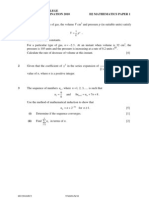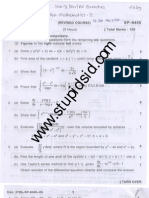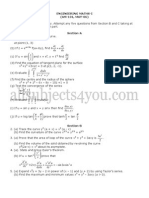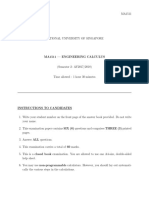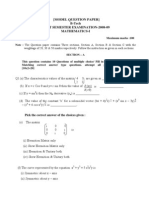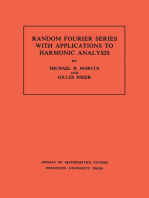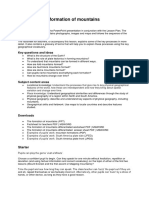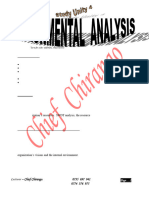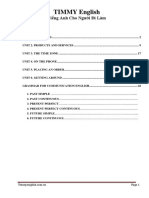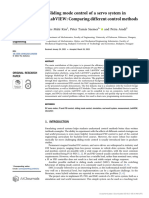CO Geometry Change of Axes (Exercise)
CO Geometry Change of Axes (Exercise)
Uploaded by
Almo KoushikCopyright:
Available Formats
CO Geometry Change of Axes (Exercise)
CO Geometry Change of Axes (Exercise)
Uploaded by
Almo KoushikOriginal Title
Copyright
Available Formats
Share this document
Did you find this document useful?
Is this content inappropriate?
Copyright:
Available Formats
CO Geometry Change of Axes (Exercise)
CO Geometry Change of Axes (Exercise)
Uploaded by
Almo KoushikCopyright:
Available Formats
uaton
onky
4) (17- 54 -63 y² 100
Ordinat
ning urs we get
--1
hich he reguired transformation
EXERCSE IV
L
Transtorm to
(a) Orgn (1, -2).paralel axes through the new origin of the equations.
tefer
the
2r² -4r 4y 0
Ans. 2r
b) Orngan (3, 1), -6r. 2y7- 0 Ans r+ 2y'+ 4y = 0.
2 Trarnsform to axes inclined at 45° to the
(D.U.1
original axes the equations.
() - Ans. 2ry a
y-2V2x- 10V2y 2- 0 Ans. y + 6x + 4yl
3. Rem¡ve the furst degree terms in each of the
following equations.
(a)a y 6r-&y- 10 =0
Ans. 5r-a
b) 2r Sy12x 10y -7= 0
Ans. 2r+
(c) 3r 4y6x + 24y- 135 =0
Ans. 3r-4
4. Prove that the value of g² +f in the equation ar² + 2hxy + by² + 2gx + fy +eal
remans uneffected by orthogonal transformation without change of origin. .
s. Transtorm he equation 1l +24ry +4y- 20x - 40y -5 =0 to rectangular axes thru
Ans. -4y+l=0
the pont 2-1) and inclined at an angle tan
Change of Axes 31
6. Determine the angle through which the axes must be rotated to remove the xy term in
he equation. 7-63ry +13y²= 16 Ans. =30°, +4y² =4
7. By transforming to parallel axes through a propetly chosen point (h, k) prove that the
quation 2r+y-y-5x 4y +11 = 0carn be reduced to one containing terms of the 2nd degree
nly. Ans. (2, 3)
8. The direction of axes remaining the same, cho0se a new origin such that the new co
brdinate of the pair of points whose old co-ordinates are (5,-13) and (-3, 11) may be the forms
h, k) and ( , -k) [N.U.H. 1997 ]Ans. (1, -1)
9. Transform the equation 17 + 18ry-7y2-16x-32y - 18 = 0 to one in which there is
no term involving x, y and xy, both sets of axes being rectangular.
[N.U. H.2003 ]Ans. (1,-1),} tan-l3/4, 2-y' =1
10. Transform the axes inclined at 30° to the original axes the equation, *"+ 2V3xy
2 = 242 [N.U. H. 2009, 1999 ] Ans. -y=a'
transformed to 4x? + 2y' = 1 when
11. The equation 3x + 2xy + 3y'-18x- 22y + 50 = 0 is
Find the inclination of the latter axes to
eferred to rectangular axes through the point (2, 3).
[N.U. H. 2004 ][R.U. 1960]
he former.
You might also like
- The Secrets of Manifestation PDFDocument38 pagesThe Secrets of Manifestation PDFruss90% (10)
- Handbook of Bolts and Bolted John Bickford Sayed Nassar Id5950Document1 pageHandbook of Bolts and Bolted John Bickford Sayed Nassar Id5950Syed Majeed57% (7)
- Creativity Intelligence TestDocument4 pagesCreativity Intelligence Teststar6night41% (22)
- Coordinate Geo Rahman ExerciseDocument2 pagesCoordinate Geo Rahman Exercisepranjal farhanNo ratings yet
- Maths 1bDocument3 pagesMaths 1bMunna ManoharNo ratings yet
- MA 101 Assignment-II-1Document2 pagesMA 101 Assignment-II-1Aditya GuptaNo ratings yet
- Rotation of AxesDocument12 pagesRotation of AxesarjunsaiNo ratings yet
- All Frombr Paper For Math 1 MergedDocument139 pagesAll Frombr Paper For Math 1 MergedunknownNo ratings yet
- 14 A Level June 1970 - Paper 5Document4 pages14 A Level June 1970 - Paper 5Devin Ky100% (1)
- Tpde Re ModelDocument2 pagesTpde Re ModelTamil VananNo ratings yet
- 2010 IJC H2 Maths Prelims2 P1 - QP - RDocument5 pages2010 IJC H2 Maths Prelims2 P1 - QP - RbluplerNo ratings yet
- Exercise 1.0 (Main)Document14 pagesExercise 1.0 (Main)rockydalabehera94No ratings yet
- Vector Calculus Tutorial Sheet-4Document2 pagesVector Calculus Tutorial Sheet-4rahulraj2901nksNo ratings yet
- UACE MATHEMATICS PAPER 1 2013 Marking GuideDocument15 pagesUACE MATHEMATICS PAPER 1 2013 Marking Guideelijahmachael32No ratings yet
- Aims Mathematics 2B Important Questions List 2019 20Document8 pagesAims Mathematics 2B Important Questions List 2019 20Earn real money Earn real moneyNo ratings yet
- 12th PageDocument2 pages12th Pagehsri60331No ratings yet
- Solved Paper 4 2Document9 pagesSolved Paper 4 2xariso5901No ratings yet
- Adobe Scan 16 Dec 2023Document11 pagesAdobe Scan 16 Dec 2023adityasingh2692006No ratings yet
- 6th Sem Maths PreviouDocument4 pages6th Sem Maths PrevioulycanxhariNo ratings yet
- Important QuestionsDocument9 pagesImportant Questionsanilkumarchella100% (7)
- April 2006Document90 pagesApril 2006செபா செல்வாNo ratings yet
- 63c02536-a452-4fff-98bd-0b76a280a6f3.pdfDocument2 pages63c02536-a452-4fff-98bd-0b76a280a6f3.pdfbillowriarohit64No ratings yet
- Dec 2009Document2 pagesDec 2009Yameen DasadiyaNo ratings yet
- Calculus AssignmentDocument2 pagesCalculus AssignmenttNo ratings yet
- 2006Document2 pages2006harry221992No ratings yet
- SR Maths - IIB Important QsDocument23 pagesSR Maths - IIB Important QsKeerthana100% (2)
- M1 R08 January 09Document3 pagesM1 R08 January 09aathavan1991No ratings yet
- U20ma301 Tpde Model Set 1Document4 pagesU20ma301 Tpde Model Set 1PriyankaNo ratings yet
- MATHS IB QUESTION BANK Chapter Wise Important Questions For IPE PDFDocument28 pagesMATHS IB QUESTION BANK Chapter Wise Important Questions For IPE PDFKiran Kumar0% (2)
- Analytic Geo Lecture ExamplesDocument4 pagesAnalytic Geo Lecture ExamplesJayloyd LaraNo ratings yet
- Solved Paper 3 2Document9 pagesSolved Paper 3 2xariso5901No ratings yet
- Engineering Mathematics - III (MAT-ELE-201) RCSDocument4 pagesEngineering Mathematics - III (MAT-ELE-201) RCSAbhijan Carter BiswasNo ratings yet
- 14 A Level June 1970 - Paper 5Document4 pages14 A Level June 1970 - Paper 5dlnmch097No ratings yet
- 1718sem2 Ma1511Document3 pages1718sem2 Ma1511杨过No ratings yet
- Year 12 Term 2 Assessment 2007 - EXTENSION II: Question 2 (B) Continued On Next PageDocument3 pagesYear 12 Term 2 Assessment 2007 - EXTENSION II: Question 2 (B) Continued On Next Pagenoah smithNo ratings yet
- MP 1 PaperDocument4 pagesMP 1 Paperbhoot1910No ratings yet
- CVT Q.BDocument7 pagesCVT Q.Brh11092004No ratings yet
- 25 Pure Maths Resourceful Mock 2016-2Document4 pages25 Pure Maths Resourceful Mock 2016-2BWENGYE NICHOLASNo ratings yet
- Model Paper MathematicsDocument5 pagesModel Paper Mathematicsamitkawasthi100% (1)
- Exercise 1.2 (Main)Document12 pagesExercise 1.2 (Main)rockydalabehera94No ratings yet
- frdA110920A1626811Document2 pagesfrdA110920A1626811jalaluddinakbar1456No ratings yet
- Adobe Scan 14 Mar 2024 (2)Document3 pagesAdobe Scan 14 Mar 2024 (2)Asif ShaikNo ratings yet
- Ap 13 - 045Document16 pagesAp 13 - 045dhanalakshi755No ratings yet
- Homework 9Document2 pagesHomework 9ardagecimli70No ratings yet
- Tutorial 13BDocument2 pagesTutorial 13BSk CreationsNo ratings yet
- James Ruse 1990 4U TrialDocument3 pagesJames Ruse 1990 4U TrialDean PhamNo ratings yet
- Intermediate Mathematics 2B LAQ and SAQ-1Document6 pagesIntermediate Mathematics 2B LAQ and SAQ-1SalmanAnjans79% (29)
- IAS Mains Mathematics 1998Document8 pagesIAS Mains Mathematics 1998Suresh BabuNo ratings yet
- B.sc. II Sem, Mathematics - Paper - II - Unit IV & Unit - VDocument34 pagesB.sc. II Sem, Mathematics - Paper - II - Unit IV & Unit - VKamran 123No ratings yet
- JR Maths - IbDocument2 pagesJR Maths - IbSaket Gunda 10DNo ratings yet
- JR Maths - IbDocument2 pagesJR Maths - Ibsimplesimha08No ratings yet
- TS Ipe 2023Document16 pagesTS Ipe 2023mittapallybunny13No ratings yet
- Tutorial 2Document2 pagesTutorial 2keldyntayeg1No ratings yet
- M1 (1st) Dec2017Document2 pagesM1 (1st) Dec2017Aastha DuaNo ratings yet
- 7 Marks & 4 Marks (IB)Document6 pages7 Marks & 4 Marks (IB)kc802220No ratings yet
- Mathematics IiiDocument3 pagesMathematics Iiiannsusanmathew289No ratings yet
- Curvature and Radius of CurvatureDocument1 pageCurvature and Radius of CurvatureMad MaxNo ratings yet
- Solved Paper 2 2Document9 pagesSolved Paper 2 2xariso5901No ratings yet
- Inter Material Istyearem Mathsib 02 - 02 - Rotation - of - Axes UnlockedDocument12 pagesInter Material Istyearem Mathsib 02 - 02 - Rotation - of - Axes UnlockedmohithapanandNo ratings yet
- 02 02 Rotation of Axes PDFDocument12 pages02 02 Rotation of Axes PDFdeepakNo ratings yet
- Transformation of Axes (Geometry) Mathematics Question BankFrom EverandTransformation of Axes (Geometry) Mathematics Question BankRating: 3 out of 5 stars3/5 (1)
- Random Fourier Series with Applications to Harmonic AnalysisFrom EverandRandom Fourier Series with Applications to Harmonic AnalysisNo ratings yet
- AYURVIMARSHADocument4 pagesAYURVIMARSHAMaharshi L' st.No ratings yet
- Janapriya Multiple Campus: BMTM / First Semester / ENG 111: English-IDocument3 pagesJanapriya Multiple Campus: BMTM / First Semester / ENG 111: English-ISophiya PrabinNo ratings yet
- Assignment - Inclusion-Exclusion Principle1Document2 pagesAssignment - Inclusion-Exclusion Principle1aumkolekar2712No ratings yet
- BUS 5110 Week 6 DiscussionDocument1 pageBUS 5110 Week 6 DiscussionSAMNo ratings yet
- Trends Module Trends Networks and Critical ThinkingDocument33 pagesTrends Module Trends Networks and Critical ThinkingjohnNo ratings yet
- Lesson 3: The Formation of Mountains Lesson Plan: Key Questions and IdeasDocument4 pagesLesson 3: The Formation of Mountains Lesson Plan: Key Questions and IdeasVinujah SukumaranNo ratings yet
- Grade IV Matatag Exam 2024Document3 pagesGrade IV Matatag Exam 2024Hazel MartinaNo ratings yet
- Week 4 Why Am I Like This Personal Development 12Document16 pagesWeek 4 Why Am I Like This Personal Development 12Jedmars Dela Rosa TayloNo ratings yet
- Speaking Paper 3 SPM Trial Set BDocument7 pagesSpeaking Paper 3 SPM Trial Set BFarahaini Mohd PerangNo ratings yet
- BM303 - Chapter 4 - Internal Environmental AnalysisDocument14 pagesBM303 - Chapter 4 - Internal Environmental AnalysisNessa NessaNo ratings yet
- Form 4 Reading Unit 2aDocument3 pagesForm 4 Reading Unit 2ahusnaalizan98No ratings yet
- Lecture 6 Part OneDocument11 pagesLecture 6 Part OneJaykeNo ratings yet
- English Week 2Document2 pagesEnglish Week 2Ariadna ApolonioNo ratings yet
- Unit1 Introduction To AIDocument8 pagesUnit1 Introduction To AIedaNo ratings yet
- ECL Próbavizsga Pécsi Tudományegyetem Idegen Nyelvi TitkárságDocument4 pagesECL Próbavizsga Pécsi Tudományegyetem Idegen Nyelvi TitkárságEvelin SeresNo ratings yet
- L4W4 ChemicalChangeDocument21 pagesL4W4 ChemicalChangefranchesca nicoleNo ratings yet
- Gregg ShorthandDocument4 pagesGregg ShorthandRosemarie HerreraNo ratings yet
- TIMMY English: Tiếng Anh Cho Người Đi LàmDocument56 pagesTIMMY English: Tiếng Anh Cho Người Đi Làmnguyễn đứcNo ratings yet
- ComparativoElginPequeno 20140827082553Document2 pagesComparativoElginPequeno 20140827082553Aurizio BentoNo ratings yet
- Arjuna JEE Main Test 01 - ChemistryDocument6 pagesArjuna JEE Main Test 01 - Chemistrymriitian56No ratings yet
- AB1202 CheatsheetDocument2 pagesAB1202 Cheatsheetk62.2312535017No ratings yet
- BA 16 Midterm ModuleDocument9 pagesBA 16 Midterm ModuleCrixx LeeNo ratings yet
- Msds SIGMATHERM 540 (ENG) (sk-19-07-07leg-MT)Document8 pagesMsds SIGMATHERM 540 (ENG) (sk-19-07-07leg-MT)AZLAN ABDULLAINo ratings yet
- Math 1100Document3 pagesMath 1100nasherlydiazNo ratings yet
- Sliding Mode Control of A Servo System in LabVIEWDocument10 pagesSliding Mode Control of A Servo System in LabVIEWSaleem RiazNo ratings yet
- Atomic Molecular Physics Lecture 5Document58 pagesAtomic Molecular Physics Lecture 5AnikaNo ratings yet
- Form 2-English Yearly Plan 2021 SMK Sungai Damit, TuaranDocument3 pagesForm 2-English Yearly Plan 2021 SMK Sungai Damit, TuaranEve in BaliNo ratings yet










